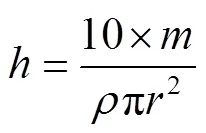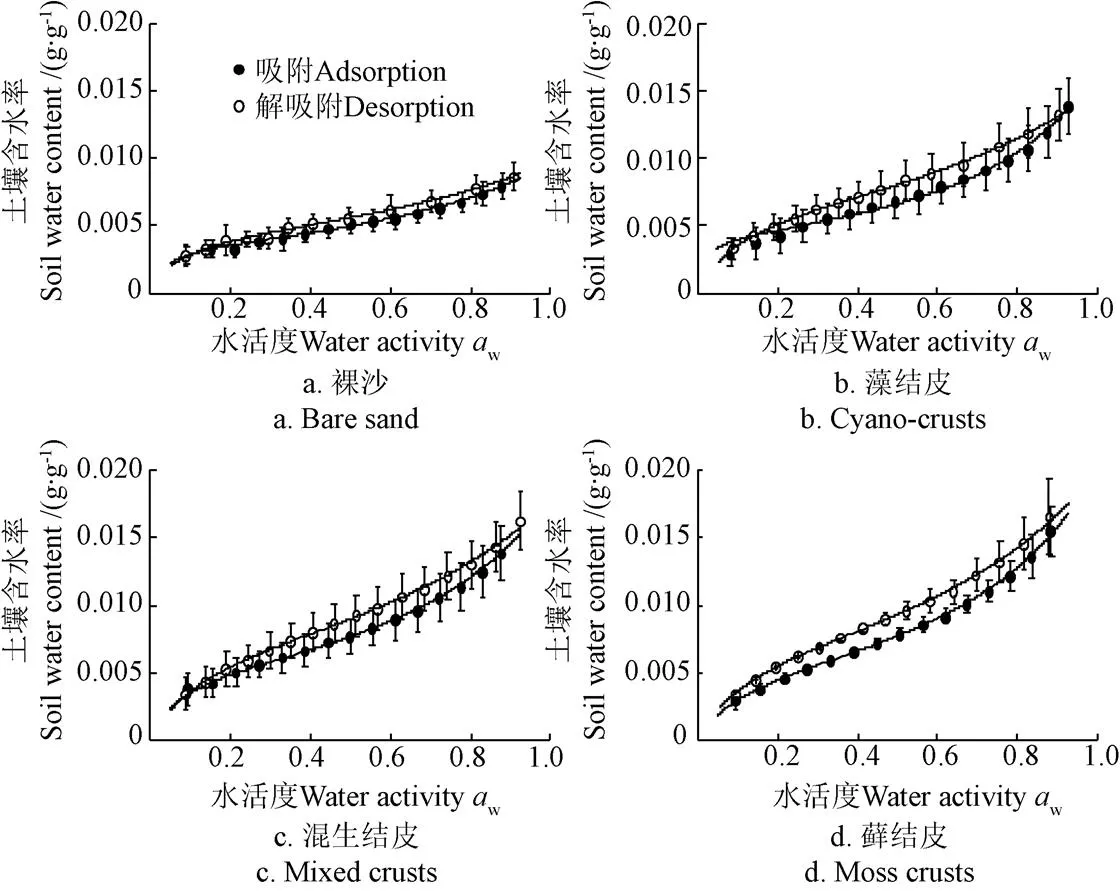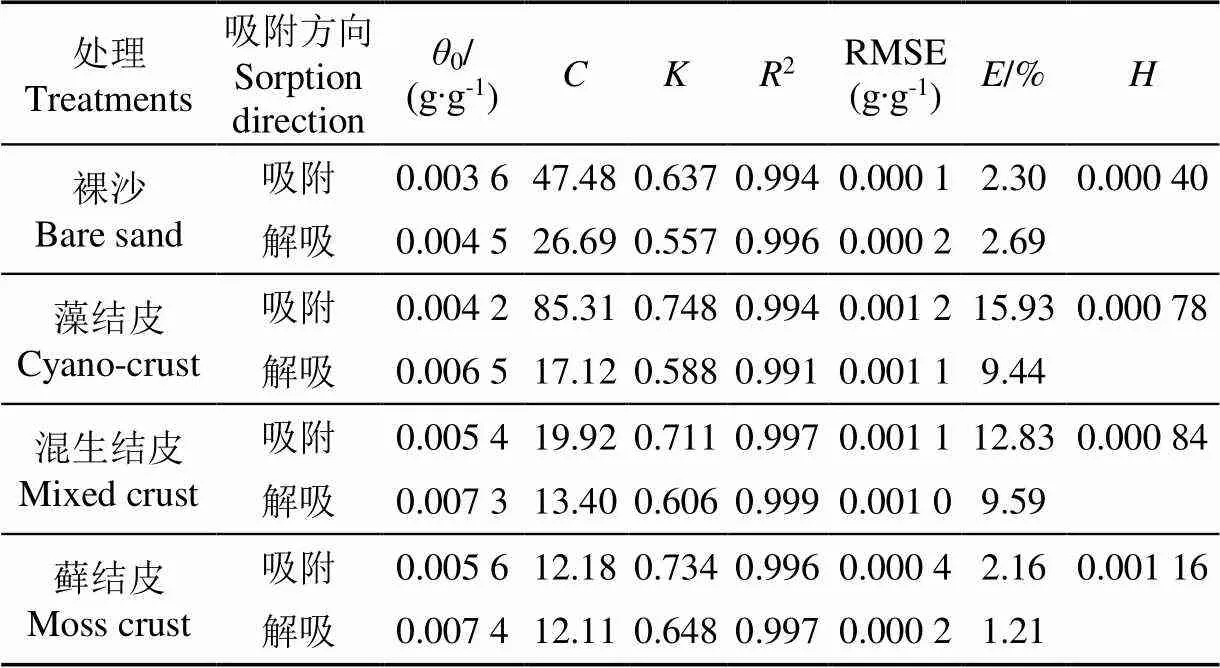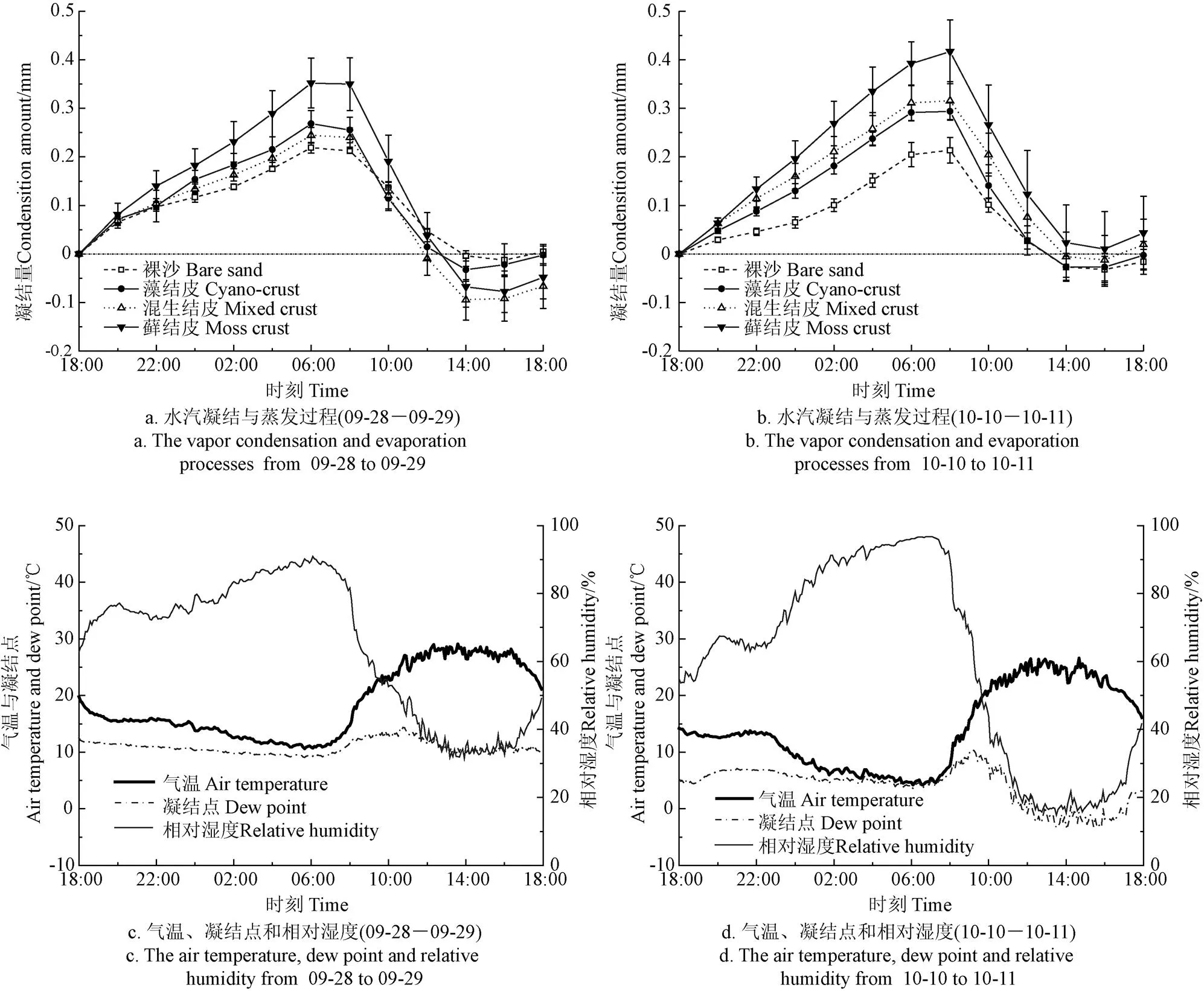黄土高原干旱半干旱区生物结皮覆盖土壤水汽吸附与凝结特征
2020-09-20李胜龙孙福海
李胜龙,肖 波,3,孙福海
·农业水土工程·
黄土高原干旱半干旱区生物结皮覆盖土壤水汽吸附与凝结特征
李胜龙1,2,肖 波1,2,3※,孙福海1,2
(1. 中国农业大学土地科学与技术学院,北京 100193;2. 农业农村部华北耕地保育重点实验室,北京 100193;3. 中国科学院水土保持研究所黄土高原土壤侵蚀与旱地农业国家重点实验室,杨凌 712100)
生物结皮是一种广泛分布于干旱半干旱地区土壤表层的特殊复合体,为揭示其对土壤水汽吸附与凝结过程的影响,该研究通过室内定量水汽吸附试验和野外对水汽凝结的连续观测,对黄土高原典型生物结皮(藻结皮、藻藓混生结皮、藓结皮)与裸沙的水汽吸附和凝结特征进行对比研究。结果表明:生物结皮的覆盖显著提升了表层土壤的水汽吸附能力,其平均水汽吸附量比裸沙高66.7%。不同类型生物结皮水汽吸附能力差异显著,表现为藓结皮最高,混生结皮次之,而藻结皮最低。GAB(Guggenheim-Anderson-de Boer)吸附模型能较好的描述生物结皮土壤水汽吸附与解吸附过程,模拟结果决定系数2>0.99、均方根误差RMSE<0.001 2 g/g及平均相对偏差百分比<16.0%;此外,生物结皮加剧了土壤水汽吸附与解吸附曲线之间的滞后效应,其滞后指数平均是裸沙的2.0~2.9倍。水汽凝结结果显示,水汽凝结过程均受气温与相对湿度等气象因子制约,且生物结皮覆盖下表层土壤的水汽凝结和蒸发过程相较于裸沙更为迅速。同时,生物结皮的日均水汽凝结量是裸沙的1.6~1.8倍。综上,干旱和半干旱地区生物结皮覆盖显著提高了表层土壤的水汽吸附能力、并增加了水汽凝结量,对区域表层土壤的水分运动过程产生了重要影响。
土壤;水分;水汽吸附量;GAB模型;凝结水;微型蒸渗仪;黄土高原
0 引 言
中国干旱和半干旱面积超过2.56×106km2,区域荒漠化严重,生态环境脆弱[1-2]。黄土高原作为典型的干旱和半干旱区,受特殊地质背景与气象因素影响,该区域与的风蚀、水蚀作用强烈。由于该区不仅干旱缺水,且近现代以来长期的不合理土地利用方式,使得该区土壤沙化和水土流失程度加剧[3-4]。研究显示,黄土高原年侵蚀量超过10 000 t/(km2∙a),严重制约了区域生态环境改善及经济建设[2]。自20世纪70年代起,黄土高原地区实施的水土流失治理措施(退耕还林、还草等)取得显著成效[1]。在植被恢复及生态重建过程中,生物结皮广泛发育(覆盖度约30%~40%),部分地区覆盖度超过70%[5]。
生物结皮(Biological soil crusts或biocrusts)是由微生物、蓝绿藻、地衣、苔藓等微小生物体与沙粒胶结形成的特殊复合体[6-7]。作为地表生态景观及生态系统的重要组成部分,虽然生物结皮自身较薄,但其能显著影响表层土壤理化性质,提升表层土壤的养分含量,改善土壤结构[5,7]。同时,其特殊的结构不仅会降低水分入渗过程,提升表层土壤含水率,而且其较高的热导率会使得土壤表层增温、降温过程加快,最终影响表层物质能量循环与转换(如水分蒸发与凝结)[7-9]。因此,生物结皮在干旱半干旱区的土壤生态、土壤水文、土壤生物和地球化学循环过程及区域生态修复过程中发挥重要作用[6,8,10]。
土壤水汽吸附是水汽以膜状水和吸湿水等形式逐层附着在土壤颗粒表面的过程,其在水汽扩散、有机组分的吸附和挥发等过程中具有重要作用[11-12]。一般而言,水汽吸附过程主要受土壤颗粒的比表面积影响,而不同质地土壤颗粒比表面积的差异会显著影响水汽吸附能力[11,13]。为探究土壤水汽吸附过程,通常以水汽吸附等温(Water vapor Sorption Isotherms,WSIs)曲线描述给定环境条件下土壤含水率与相对湿度之间的关系[11]。为量化及模拟水汽吸附过程,已有较多吸附模型被用于土壤水汽吸附过程的研究,如Brunauer-Emmett-Teller(BET)模型和Guggenheim-Anderson-de Boer(GAB)模型等,均能较好模拟土壤水汽吸附过程[11,14]。此外,水汽吸附和解吸附曲线两者并不能完全重合,滞后效应(Hysteresis effect)明显,而探究水汽吸附的滞后效应也能准确评估不同质地土壤水汽吸附能力[14]。目前,针对生物结皮覆盖下土壤水汽吸附特征的研究较少,仅有的相关研究则忽略吸附过程,缺乏生物结皮水汽吸附过程及内在机理的探讨[15-16]。因此,准确量化生物结皮水汽吸附特征,能量化表层土壤水汽传输与凝结的影响。
土壤水汽凝结是蒸发的逆过程,虽然凝结量较蒸发或降雨少,却能为植物及小型动物(如土壤线虫和昆虫)提供必要的生存水源[8,17]。凝结水的水汽来源主要包括土壤内部水汽传输和近地表空气,受空气水汽压和土壤表层温度梯度的影响,水汽由气态转化为液态凝结于土壤表层,从而补充干旱地区表层土壤水分[18]。研究显示,在极其干旱地区(如内盖夫沙地),凝结水量可占据年均降雨量的12.6%,且凝结水在提高植物种子萌芽率和促进沙丘稳定方面具有重要作用[18-19]。生物结皮广泛分布于荒漠地区表层,其水汽凝结过程研究也是荒漠区土壤水文研究的重点。生物结皮不仅改变土壤理化性质,显著提升水汽凝结量,同时其不同结皮类型也会影响水汽凝结特征[17-19]。因此,探究生物结皮水汽凝结特征,对揭示和量化生物结皮在干旱和半干旱区域地表水量平衡的作用上具有重要意义。
随着黄土高原地区生态环境的综合治理,生物结皮在提升土壤涵养水源功能及区域生态环境建设上的作用越来越重要,然而其对表层土壤水汽吸附与凝结的影响亟需深入探讨。基于此,本研究以黄土高原典型生物结皮为研究对象,通过室内水汽吸附试验及野外水汽凝结的测定,对比生物结皮及无结皮土壤水汽吸附与凝结特征差异,揭示生物结皮覆盖下土壤水汽吸附及凝结过程特征与发生机制。研究结果可深化对生物结皮水汽传输过程的认识,从而为区域生态治理及决策提供理论指导。
1 材料与方法
1.1 研究区概况
研究区位于陕西省神木市六道沟小流域(110°21′~110°23′ E,38°46′~38°51′ N),流域海拔1 094.0~1 273.9 m,总面积为6.86 km2。该区地处温带大陆性气候区,年均气温7~9 ℃,雨热同季,无霜期243~275 d。多年平均降水量和蒸发量分别为409和1 337 mm[4],其中年降水量的70%~85%集中在4-9月。研究区是典型的水蚀风蚀生态脆弱区,土壤质地为砂质壤土和砂土[7,19]。在多年退耕还林(草)过程中,该区植被恢复较好,柠条()、油松()、沙柳()及苜蓿()等分布较广。生物结皮在该区域广泛分布,且受人为干扰较小。
1.2 试验设计与土样采集
本研究包括室内生物结皮水汽吸附过程试验和野外凝结过程测定试验两部分。其中,室内采用自动水汽吸附仪测定土壤水汽吸附与解吸附过程;野外试验以自制微型蒸渗仪(Micro-lysimeter)测定土壤水汽凝结过程及日凝结量。
野外试验与样品采集于2019年8-10月进行。生物结皮和无结皮土样均在典型风沙土表层采集。采样前通过现场调查,设置裸沙、藻结皮、混生结皮(藻藓混生)与藓结皮4种处理。选择地形平坦且生物结皮发育良好的地块围圈2 m×2 m小区(每个处理3个重复)。采用直径9 cm、高2 cm的培养皿采集生物结皮土样。采样时,先以喷壶在生物结皮表层喷洒去离子水,减少对结皮层的破坏。之后将土样带回室内进行理化性质分析测定(每个处理各采9个重复土样)。采用涂膜法测定生物结皮表层(0~2 cm)土壤容重(裸沙容重以烘干法测定,105 ℃烘干24 h);苔藓生物量的测定也以烘干法测定,先小心取一定面积(约4 cm2)的结皮土样放入网筛中小心冲洗并收集藓类植物,于烘箱中 85 ℃杀青30 min,再于65 ℃烘至恒质量后以获得苔藓生物量。其后,将剩余土样风干过筛,用重铬酸钾外加热法测定有机质及吸管法测定颗粒组成(国际制分类)[20]。各位点表层土壤基本理化性质见表1。

表1 不同处理的土壤理化性质
注:不同字母表示不同处理间在0.05水平上差异显著,下同。
Note: Different letters across data rows indicate significantly difference among different treatments at 0.05 level, same as below.
1.3 水汽吸附与解吸附试验
本文使用全自动水汽吸附仪(Decagon Devices Inc., Pullman, WA, USA)测定土壤水汽吸附与解吸附过程[11,13]。测定过程中,仪器自动对土壤样品进行干燥和加湿处理,并以高精度磁天平测定样品的质量变化,从而获得水汽吸附量,每个处理测3次。测定时,每次称取3.5 g过2 mm筛的风干土样(混生结皮和藓结皮需剪除藓株之后再过筛),均匀平铺在仪器测定的封闭容器内。采用动态露点等温线模式自动对样品进行风干或加湿,该模式下不需手动控制水分含量和水活度w(Water activity;指吸湿物质在较小的密闭容器内与周围空间达到平衡时的相对湿度,该值介于0~1.0)。测定完成后,将样品放入105 ℃烘箱烘干12 h后测定干土质量,进而获取土壤质量含水率与w的关系。
1.4 水汽凝结特征试验
本研究以表层土壤非降雨补充形式获得的水分(Non-rainfall water)表征水汽凝结量,以微型蒸渗仪连续称重获取的质量变化代表水汽凝结量。微型蒸渗仪选用内径10.5 cm、高3 cm的PVC材料进行制作[21]。采样时,先将结皮表层喷洒去离子水,小心将微型蒸渗仪垂直砸入土体,采取表层0~3 cm土壤,削平土壤底端后,以300目(约0.085 mm)纱网封底保证上下水汽传输连通效果。生物结皮与裸沙处理各设5个重复。同时,为真实反映实际水汽凝结条件,挑选地形平坦且无遮挡区域埋入内径15.5 cm、高4 cm的大PVC环(露出地表1 cm),将各蒸渗仪土样置于上述大环中,以减少外界干扰。
自2019年9月27日开始,于每天日落(约18:30,北京时间,下同)和次日日出(约06:30)用电子天平(±0.01 g)对样品进行称质量,两者差值即为当日水汽凝结量,每次称质量前均以实验棉小心擦干净PVC表面露珠及土样下端以减少误差。期间若遇阴雨天,则及时遮盖土样以减少降雨影响,待天晴后继续测定。本研究共进行了15次有效测量(期间无明显降雨)。此外,挑选连续晴朗且无大风的天气,以每2 h为间隔从18:00至次日18:00对土样进行连续称质量,获取水汽连续的凝结与蒸发过程。水汽凝结量以水深(,mm,式(1))进行计算。

式中为2次测定的质量之差,g;,水密度,此处取1.0 g/cm3;为蒸渗仪内半径,本试验为5.25 cm。
此外,整个野外试验过程中均以小型气象站连续测定空气温度、相对湿度和凝结点等气象因素(距离地面2.0 m,测定时间间隔为5 min),以探究气象因素对水汽凝结的影响。
1.5 水汽吸附过程模拟及滞后指数计算
本研究采用GAB模型对土壤水汽吸附过程进行模拟。GAB模型在土壤水汽吸附研究中使用较广,该模型能准确对各类土壤较大范围的w(>0.8)水汽吸附特征进行模拟,且多数研究结果显示该模型对黏粒、有机质含量较高的土壤有较高拟合度[11,13-14]。该模型模拟过程见式(2)。

式中θ为土壤质量含水率,g/g;0为土壤单层水汽吸附量,g/g;为描述纯液态和单层吸附的水分子自由焓差的能量常数,无量纲;参数表示纯液态和单层以上层中水分子的自由焓差,无量纲;w为水活度,无量纲[11,14],本研究水汽吸附仪测定范围为0.03~0.93。
本研究以供试土样水汽吸附与解吸附曲线围成的面积量化土壤水汽滞后效应,即滞后指数(),见式(3),评价生物结皮对表层土壤水汽吸附的影响,值越大代表滞后效应越明显。
式中di为水汽解吸附拟合函数所围成的面积,无量纲;ai为水汽吸附拟合函数所围成面积,无量纲。
同时,为评价GAB 模型在生物结皮与裸沙土壤水汽吸附曲线的拟合效果,本研究采用决定系数2和均方根误差RMSE(式(4))以及平均相对偏差百分比()(式(5))等进行综合评价。


式中θ为实测土壤含水率,g/g;θ为模型拟合所得土壤含水率,g/g;为测定样品数量。
本文运用Microsoft Excel 2016进行数据处理,用IBM SPSS Statistics 22进行方差分析与相关性分析(双变量),以OriginPro 2019进行GAB模型拟合与作图。
2 结果与分析
2.1 生物结皮土壤水汽吸附与解吸附特征
如图1,土壤水汽吸附量随w的增加逐渐上升,且对比各曲线斜率可知,受生物结皮覆盖影响,结皮层土壤水汽吸附过程较快,且极大提升土壤水汽吸附量。在w为0.03~0.93条件下,裸沙表层土壤水汽吸附量平均从0.002 g/g上升至0.009 g/g,藻结皮、混生结皮和藓结皮水汽吸附量均高于0.015 g/g,平均高出裸沙的66.7%。其中藓结皮水汽吸附量由0.002 g/g上升至0.020 g/g,其吸附量是裸沙的1.0~2.2倍。

图1 不同处理土壤水汽吸附及解吸过程
为精确对比不同处理水汽吸附特征差异,本研究选取w>0.8时水汽吸附量进行分析。如图2,水汽吸附量从大到小依次为藓结皮、混生结皮、藻结皮、风沙土(=178.27,<0.001),且生物结皮类型的不同也会导致水汽吸附特征产生显著差异。各处理中,裸沙平均水汽吸附量仅为0.008 g/g,而藻结皮在该阶段平均水汽吸附量(0.012 g/g)是裸沙的1.5倍。相对于裸沙和藻结皮,结皮表层藓株的形成能显著提升水汽吸附量。w>0.8时,混生结皮和藓结皮的水汽吸附量为0.014和0.016 g/g,分别是裸沙的1.8和2.0倍。

注:不同字母表示不同处理在0.01水平上差异显著。
2.2 生物结皮土壤水汽吸附过程模拟及其滞后特征
表2显示土样GAB模型模拟的2均在0.99以上,RMSE均低于0.0012 g/g,且均低于16.0%,模拟效果较好。其中,GAB模型中参数0为土壤单层水汽吸附量,是指在整个水汽吸附曲线中w介于0.20~0.21之间的土壤水含率,该值能反映土壤初始吸附速率的快慢。通过对比实测值和拟合值可知,各土样在0.20 表3显示,在吸附曲线中,0与土壤容重呈显著负相关关系(=-0.96,<0.05);而解吸附曲线内,0与土壤砂粒含量呈显著负相关关系(=-0.97,<0.05),其参数与容重和砂粒呈显著正相关关系(≥0.96,<0.05)。解吸附过程较吸附过程平缓,在相同含水率下,解吸附曲线含水率高于吸附曲线。对比值(滞后指数)可知,各土壤表层吸附与解吸附曲线之间滞后作用明显,且生物结皮增大表层土壤的(表2),其滞后指数整体是裸沙的2.0~2.9倍。此外,不同生物结皮从大到小依次为藓结皮、混生结皮、藻结皮、裸沙,表明生物结皮水汽吸附滞后效应更明显。 表2 GAB模型拟合参数 注:0为土壤单层水汽吸附量,g∙g-1;为描述纯液态和单层吸附的水分子自由焓差的能量常数;为纯液态和单层以上层中水分子的自由焓差;为平均相对偏差百分比,%;为滞后指数。 Note:0is the soil water content at monolayer coverage, g∙g-1;is the energy constant that depicts the difference in free enthalpy of the water molecules in the pure liquid state and in the monolayer;represents the difference in free enthalpy of the water molecules in the pure liquid and the layers above the monolayer;is mean relative percentage deviation modulus, %;is hysteresis index. 表3 土壤理化性质与GAB模型拟合参数的相关系数 注:*表示变量在0.05水平(双侧)上显著相关。 Note: * indicates the variables significantly correlated at the 0.05 level (both sides). 气温和相对湿度对水汽凝结影响较大(图3和表4)。凝结量与气温呈显著负相关关系(||>0.65,<0.001),而其与相对湿度呈显著正相关(>0.75,<0.001)。在气温和相对湿度的影响下,土壤单日水汽凝结过程呈现为先增加,在06:00-08:00达到最大值;之后凝结水迅速蒸发减少,并在14:00-15:00达到最低值(图3)。其中10月凝结点与气温比9月低,相对湿度较9月高,导致整体上水汽凝结量较9月高。在单日周期内,日出前后(约07:00)凝结点与气温达到最低,而相对湿度最高,各位点凝结量均达到最大值。而在日落前3~4 h(约15:00),气温达到最大,而相对湿度和凝结点较低,各土样的水汽凝结量蒸发耗尽后土壤含水率达到最低值,随后逐渐吸湿且质量回升。 对比水汽凝结曲线斜率可知,生物结皮覆盖下表层土壤水汽凝结速率和蒸发速率均高于裸沙(图3a和3b)。其中,生物结皮在9月单日水汽凝结量最大值超过0.27 mm,平均是裸沙的(0.18 mm)的1.5倍;而在10月所测的水汽凝结量较9月有所上升,其中生物结皮所测得的单日水汽凝结量均超过0.29 mm,平均是裸沙(0.21 mm)的1.4倍。此外,土壤水汽凝结量均在15:00达到最小值,此时生物结皮土壤吸湿凝结水分与裸沙差异较小,甚至出现结皮层土壤水汽凝结量低于裸沙的现象,如9月测定的藻结皮、混生结皮和藓结皮水汽凝结量蒸发较快,在12:00之后均低于裸沙(图3c)。而15:00之后,各位点土壤则重新出现水汽吸湿凝结而质量增加现象。 图3 不同处理土壤水汽累积凝结量及气象因子 表4 土壤水汽日凝结水量与气象要素相关性分析 注:*和**分别表示凝结量与气象因子在0.05和0.01水平上显著相关。 Note: Symbols of *and** mean significantly correlation between meteorological factors and daily vapor condensation at the 0.05 and 0.01 level, respectively. 生物结皮覆盖下土壤水汽凝结量显著高于裸沙,其水汽日凝结量平均为裸沙的1.6~1.8倍(表5)。其中,藓结皮水汽凝结平均达0.20 mm,而裸沙平均仅为0.11 mm。在水汽凝结总量上,生物结皮水汽凝结总量整体高于2.7 mm,比裸沙总量(1.67 mm)提高61.7%(表5)。此外,生物结皮水汽凝结的最大值和最小值均高于裸沙。不同结皮类型水汽日凝结量虽无显著差异,但藓结皮日凝结量最高(0.20 mm),平均比裸沙、藻结皮和混生结皮高81.8%、11.1%和5.3%(表5)。 表5 不同处理水汽日凝结量描述统计 本研究中,生物结皮显著提升表层土壤水汽吸附能力,其水汽吸附量比裸沙高66.7%。一般而言,土壤团聚体大小分布特征、土壤黏粒含量以及有机质含量等是影响水汽吸附能力的重要因素,不同质地土壤理化性质差异较大,直接导致土壤水汽吸附能力不同[11-12]。生物结皮广泛分布于干旱和半干旱地区地表,虽自身较薄(一般几毫米至几厘米),但其对表层土壤理化性质及土壤结构会产生重要影响[21-22]。本研究中,生物结皮显著提升了土壤黏粒含量及有机质含量含量(表1)。土壤的黏土矿物含量较高时会增大土壤颗粒的比表面积,增加水汽附着点,从而显著提高水汽吸附能力;此外,土壤有机质自身含有的亲水官能团(如羟基、酚类和羧基)可与水分子形成氢键而成为吸附中心,土壤有机质较高能在增加水分子吸附位点的同时增加水汽吸附量[11,14],综上,生物结皮较高的黏粒和有机质含量导致其水汽吸附量高于裸沙。 此外,土壤团聚体、孔隙结构及黏土矿物类型等也会影响水汽吸附量[21]。在极其干旱条件下,水分以吸湿水和膜状水等形式附着于土壤颗粒表层。Arthur等[13]研究土壤施加生物炭后水汽吸附特征结果表明,生物炭的添加能提高土壤比表面积,增加细小团聚体比重并改善土壤结构,显著提升土壤水汽吸附能力。由于土壤孔隙连通性强有利于水汽的对流与弥散,且土壤孔隙结构及孔隙分布状况对水汽吸附具有较大影响[12,23]。研究表明,不同黏土矿物(高岭石、蒙脱石、伊利石)会使得土壤结构产生较大差异,从而导致土壤水汽吸附能力不同[11,14]。生物结皮具有特殊的表层结构,且藓结皮较其他类型结皮的细小孔隙率较高,孔隙连通性增强[22,24],从而藓结皮水汽吸附能力最强。 生物结皮显著提升表层土壤水汽吸附能力,也增大水汽吸附滞后效应,其滞后指数是裸沙的2.0~3.0倍。在土壤干湿循环过程中,滞后效应普遍发生在土壤水分特征曲线中,如接触角理论、“瓶颈”效应以及土壤膨胀收缩作用等理论均对该现象有较为充分的解释,并阐明了土壤几何形状对水分特征曲线滞后效应的影响[25]。生物结皮广泛分布在干旱和半干旱地区土壤表层,结皮层土壤结构性较风沙土更佳,这是导致其水汽吸附和解吸附的干湿循环中滞后作用较为明显的主要原因。此外,相对于一般土壤水分运动过程(如入渗和蒸发),水汽吸附过程主要以膜状水和吸湿水的变化为主,该过程的滞后效应主要受土壤理化性质的影响[11,13]。研究表明,土壤有机质含量的共价键和氢键的作用对水汽吸附、解吸附曲线滞后现象产生较大影响[13]。尤其是在砂质土壤中,土壤有机质和黏粒含量的增加,会导致水汽在解吸附过程中需要消耗更多的能量将水分从土壤颗粒表面移除,而滞后效应随有机质含量和黏土矿物含量的增加而越明显[23,26]。除此之外,不同生物结皮类型对表层土壤理化性质影响程度不同,尤其是藓结皮极大提升0~5 cm土壤团聚体、含水率、有机碳甚至总氮含量[27],此类因素均导致藓结皮水汽滞后指数显著高于裸沙及其他类型结皮。 除理化性质外,生物结皮自身特殊属性也会对滞后效应产生较大影响[28-29]。研究显示,藻类、地衣或生物结皮等菌类会分解有机质,使得土壤表面形成蜡质外层,这不仅提高土壤的斥水性,也会扩大滞后效应[28]。Ding等[29]研究发现,在水汽吸附与解吸附过程中,去除蜡质层有机物质的土壤滞后效应显著低于未去除的土壤,且通过改变有机质组成成分能显著影响水汽吸附的滞后效应。生物结皮(尤其是藓结皮和地衣结皮等)在提升土壤黏粒含量的同时,不仅会提高土壤斥水性,也会提升有机质含量。如有研究显示生物结皮表层0~1 cm有机碳含量能达到40 g/kg以上[27],这使得吸湿和脱湿曲线中滞后作用差异愈发明显,也解释了生物结皮水汽吸附量及滞后指数均高于裸沙的现象。 本研究显示,生物结皮土壤水汽凝结量显著高于裸沙,其日凝结量平均是裸沙的1.2~2.4倍。通常土壤表层凝结水的水汽来源主要有3种:近地面空气中水汽、土壤内部水汽、植物蒸腾和呼吸作用所散逸的水汽[21]。受日气温差和地温差[18]、近地表空气相对湿度和近地表气温[30]、土壤含水率[17,19]和风速[31]等因素的影响,表层土壤水汽特征产生较大分异。且土壤质地的差异会改变地表下垫面地表反射率,影响表层土壤微气象,最终导致土壤凝结水量不同[18,30]。如前文所述,生物结皮一方面极大改变表层土壤理化性质,且结皮层作为特殊的表层土壤,其地表粗糙度较高[32-33]。尤其是藓结皮,相较于藻结皮和混生结皮,其藓株不仅增加地表粗糙度[33],还会很大程度上拦截地表水汽,从而提高凝结水的形成速率和增加水汽凝结量[21,34]。研究显示,土壤表层0~3 cm土壤凝结水整个土壤剖面凝结量的大部分,且藓结皮能提升凝结水形成速率平均达到0.04 mm/h[21]。此外,也有研究显示不同类型生物结皮的水汽凝结量差异显著,凝结量从大到小表现为苔藓结皮、地衣结皮、藻结皮和裸沙,藓结皮日凝结量是其他结皮的1.3~1.5倍[32]。这也印证了本研究中藓结皮水汽凝结量最高的结果。 此外,生物结皮覆盖会改变土壤热特性,导致表层土壤增温、降温过程和水热平衡能力发生改变,最终影响水汽凝结过程。目前生物结皮能显著增加表层土壤温度已经成为共识[4,35],一方面,生物结皮较深的颜色能降低地表反射率从而提升表层土壤吸热能力;另一方面,生物结皮层较高的热导率和热容量会造成其增温和降温速率明显高于裸沙[4,36],在增大日温差的同时也提升水汽凝结量。Chamizo等[27]和Kidron等[8,19]也发现,藓结皮表层温度显著高于无结皮,生物结皮的0~5 cm土壤平均温差较无结皮高3.9 ℃。综上,藓结皮表层温度的急剧变化,使得水汽凝结过程较裸沙更快、凝结量更高。 1)黄土高原生物结皮对表层土壤水汽吸附具有显著影响。由于生物结皮黏粒含量和有机质含量显著高于裸沙,表层土壤水汽吸附能力显著提升,藻结皮、混生结皮和藓结皮平均水汽吸附量比裸沙高66.7%。且不同生物结皮类型的水汽吸附能力从大到小为为藓结皮、混生结皮和藻结皮。 2)生物结皮覆盖提升了表层土壤的水汽吸附与解吸附的滞后效应,结皮层滞后指数整体上是裸沙的2.0~2.9倍。其中,藓结皮滞后指数最高,而裸沙最低。此外,GAB模型能够较好模拟生物结皮覆盖土壤水汽吸附和解吸附过程,模型模拟结果的2>0.99,RMSE<0.001 2 g/g,且平均相对偏差百分比<16.0%, 3)受近地面气象及地表下垫面等因素的共同影响,生物结皮显著提升表层土壤水汽凝结量,其日平均水汽凝结量平均是裸沙的1.6~1.8倍。且不同结皮类型水汽凝结量表现为藓结皮最高,混生结皮其次,藻结皮最低。 致谢:感谢陈冲副教授及李渊博、王芳芳等研究生对本文试验数据获取提供的帮助。 [1] Cao S X, Chen L, Yu X X. Impact of China’s grain for green project on the landscape of vulnerable arid and semi-arid agricultural regions: A case study in northern Shaanxi Province[J]. Journal of Applied Ecology, 2009, 46(3): 536-543. [2] Zhao Y G, Xu M X. Runoff and soil loss from revegetated grasslands in the hilly Loess Plateau region, China: Influence of biocrust patches and plant canopies[J]. Journal of Hydrologic Engineering, 2013, 18(4): 387-393. [3] Gao L Q, Bowker M A, Xu M X, et al. Biological soil crusts decrease erodibility by modifying inherent soil properties on the Loess Plateau, China[J]. Soil Biology and Biochemistry, 2017, 105: 49-58. [4] Xiao B, Ma S, Hu K L. Moss biocrusts regulate surface soil thermal properties and generate buffering effects on soil temperature dynamics in dryland ecosystem[J]. Geoderma, 2019, 351: 9-24. [5] 赵允格,许明祥,Jayne Belnap. 生物结皮光合作用对光温水的响应及其对结皮空间分布格局的解译:以黄土丘陵区为例[J]. 生态学报,2010,30(17):4668-4675. Zhao Yunge, Xu Mingxiang, Jayne Belnap. Response of biocrusts photosynthesis to environmental factors: A possible explanation of the spatial distribution of biocrusts in the hilly Loess Plateau region of China[J]. Acta Ecologica Sinica, 2010, 30(17): 4668-4675. (in Chinese with English abstract) [6] Li X R, Jia R L, Zhang Z S, et al. Hydrological response of biological soil crusts to global warming: A ten-year simulative study[J]. Global Change Biology, 2018, 24(10): 4960-4971. [7] Xiao B, Sun F H, Hu K L, et al. Biocrusts reduce surface soil infiltrability and impede soil water infiltration under tension and ponding conditions in dryland ecosystem[J]. Journal of Hydrology, 2019, 568: 792-802. [8] Kidron G J. The effect of substrate properties, size, position, sheltering and shading on dew: An experimental approach in the Negev desert[J]. Atmospheric Research, 2010, 98(2/3/4): 378-386. [9] 杨凯,赵军,赵允格,等. 生物结皮坡面不同降雨历时的产流特征[J]. 农业工程学报,2019,35(23):135-141. Yang Kai, Zhao Jun, Zhao Yunge, et al. Characteristics of runoff on biological soil crust slope in different rainfall durations[J]. Transactions of the Chinese Society of Agricultural Engineering (Transactions of the CSAE), 2019, 35(23): 135-141. (in Chinese with English abstract) [10] 张建国,徐新文,雷加强,等. 极端干旱区咸水滴灌林地盐结皮对土壤蒸发的影响[J]. 农业工程学报,2010,26(9):34-39. Zhang Jianguo, Xu Xinwen, Lei Jiaqiang, et al. Effects of salt crust on soil evaporation condition with saline-water drip-irrigation in extreme arid region[J]. Transactions of the Chinese Society of Agricultural Engineering (Transactions of the CSAE), 2010, 26(9): 34-39. (in Chinese with English abstract) [11] Arthur E, Tuller M, Greve M H, et al. Applicability of the Guggenheim-Anderson-Boer water vapour sorption model for estimation of soil specific surface area[J]. European Journal of Soil Science, 2018, 69(2): 245-255. [12] Jabro J D. Water vapor diffusion through soil as affected by temperature and aggregate size[J]. Transport in Porous Media, 2008, 77(3): 417-428. [13] Arthur E, Tuller M, Greve M H, et al. Effects of biochar and manure amendments on water vapor sorption in a sandy loam soil[J]. Geoderma, 2015, 243/244: 175-182. [14] 尹英杰,陈冲,晏朝睿,等. 土壤水汽吸附曲线的模拟及其滞后效应[J]. 土壤学报,2019,56(4):838-846. Yin Yingjie, Chen Chong, Yan Chaorui, et al. Simulation and hysteresis effect of soil water vapor sorption isotherm[J]. Acta Pedologica Sinica, 2019, 56(4): 838-846. (in Chinese with English abstract) [15] Kidron G J. The effect of substrate properties, size, position, sheltering and shading on dew: An experimental approach in the Negev Desert[J]. Atmospheric Research, 2010, 98(2/4): 378-386. [16] Wang X P, Pan Y X, Hu R, et al. Condensation of water vapour on moss-dominated biological soil crust, NW China[J]. Journal of Earth System Science, 2014, 123(2): 297-305. [17] Zhang J, Zhang Y M, Downing A, et al. The influence of biological soil crusts on dew deposition in Gurbantunggut Desert, Northwestern China[J]. Journal of Hydrology, 2009, 379(3/4): 220-228. [18] 尹瑞平,吴永胜,张欣,等. 毛乌素沙地南缘沙丘生物结皮对凝结水形成和蒸发的影响[J]. 生态学报,2013,33(19):6173-6180 Yin Ruiping, Wu Yongsheng, Zhang Xin, et al. Effects of biological crusts on dew deposition and evaporation in the southern edge of the Mu Us Sandy Land, Northern China[J]. Acta Ecologica Sinica, 2013, 33(19): 6173-6180. (in Chinese with English abstract) [19] Kidron G J, Tal S Y. The effect of biocrusts on evaporation from sand dunes in the Negev desert[J]. Geoderma, 2012, 179/180: 104-112. [20] 路培,王林华,吴发启. 不同降雨强度下土壤结皮强度对侵蚀的影响[J]. 农业工程学报,2017,33(8):141-146. Lu Pei, Wang Lihua, Wu Faqi. Effect of soil crust strength on erosion under different rainfall intensity[J]. Transactions of the Chinese Society of Agricultural Engineering (Transactions of the CSAE), 2017, 33(8): 141-146. (in Chinese with English abstract) [21] Pan Y X, Wang X P, Zhang Y F. Dew formation characteristics in a revegetation-stabilized desert ecosystem in Shapotou area, Northern China[J]. Journal of Hydrology, 2010, 387(3/4): 265-272. [22] 肖波,赵允格,邵明安. 陕北水蚀风蚀交错区两种生物结皮对土壤饱和导水率的影响[J]. 农业工程学报,2007,23(12):35-40. Xiao Bo, Zhao Yunge, Shao Mingan. Effects of biological soil crust on saturated hydraulic conductivity in water-wind erosion crisscross region, North of Shaanxi Province, China[J]. Transactions of the Chinese Society of Agricultural Engineering (Transactions of the CSAE), 2007, 23(12): 35-40. (in Chinese with English abstract) [23] Grismer M.E. Water vapor absorption and specific surface[J]. Soil Science, 1987, 144(3): 233-236 [24] Menon M, Yuan Q, Jia X, et al. Assessment of physical and hydrological properties of biological soil crusts using X-ray microtomography and modeling[J]. Journal of Hydrology, 2011, 397(1/2): 47-54. [25] 邵明安,王全九,黄明斌. 土壤物理学[M]. 北京:高等教育出版社,2006. [26] Lourenço S D N, Jones N, Morley C, et al. Hysteresis in the soil water retention of a sand-clay mixture with contact angles lower than ninety degrees[J]. Vadose Zone Journal, 2015, 14(7): 1-8. [27] Chamizo S, Cantón Y, Domingo F, et al. Evaporative losses from soils covered by physical and different types of biological soil crusts[J]. Hydrological Processes, 2012, 27(3): 324-332. [28] Davis D D, Horton R, Heitman J L, et al. Wettability and hysteresis effects on water sorption in relatively dry soil[J]. Soil Science Society of America Journal, 2009, 73(6): 1947-1951. [29] Ding G, Rice J A. Effect of lipids on sorption/desorption hysteresis in natural organic matter[J]. Chemosphere, 2011, 84(4): 519-526. [30] Kidron G J, Starinsky A, Yaalon D H. Cyanobacteria are confined to dewless habitats within a dew desert: Implications for past and future climate change for lithic microorganisms[J]. Journal of Hydrology, 2014, 519: 3606-3614. [31] Jia Z F, Wang Z, Wang H. Characteristics of dew formation in the semi-arid Loess Plateau of central Shaanxi Province, China[J]. Water, 2019, 11(1): 126. [32] 刘艳梅,杨航宇,李新荣. 生物土壤结皮对荒漠区土壤微生物生物量的影响[J]. 土壤学报,2014,51(2):394-401. Liu Yanmei, Yang Hangyu, Li Xinrong. Effects of biological soil crusts on soil microbial biomass in desert area[J]. Acta Pedologica Sinica, 2014, 51(2): 394-401. (in Chinese with English abstract) [33] 王国鹏,肖波,李胜龙,等. 黄土高原水蚀风蚀交错区生物结皮的地表粗糙度特征与影响因素[J]. 生态学杂志,2019,38(10):3050-3056. Wang Guopeng, Xiao Bo, Li Shenglong, et al. Surface roughness of biological soil crusts and its influencing factors in the water-wind erosion crisscross region on the Loess Plateau of China[J]. Chinese Journal of Ecology, 2019,38(10): 3050-3056. (in Chinese with English abstract) [34] 张静,张元明,周晓兵,等. 生物结皮影响下沙漠土壤表面凝结水的形成与变化特征[J]. 生态学报,2009,29(12):6600-6608. Zhang Jing, Zhang Yuanming, Zhou Xiaobing, et al. The influence of biological soil crusts on dew deposition and characteristics of soil surface in Gurbantunggut Desert[J]. Acta Ecologica Sinica, 2009, 29(12): 6600-6608. (in Chinese with English abstract) [35] Belnap J, Büdel B. Biological Soil Crusts as An Organizing Principle in Drylands. Biological Soil Crusts: An Organizing Principle in Drylands[M]. Springer International Publishing Switzerland (outside the USA), 2016: 121-138. [36] Xiao B, Hu K L, Ren T S, et al. Moss-dominated biological soil crusts significantly influence soil moisture and temperature regimes in semiarid ecosystems[J]. Geoderma, 2016, 263: 35-46. Characteristics of water vapor sorption and condensation in biocrusts covered surface soil in arid and semiarid areas of the Loess Plateau, China Li Shenglong1,2, Xiao Bo1,2,3※, Sun Fuhai1,2 (1.,,100193,;2.(),,100193,;3.,,,712100,) Water vapor movement is one of the several important components of total (hydrological) water flux in the vadosezone of drylands. When the soil water content is relatively low, the vapor sorption and condensation naturally become vitalwater sources for plants, insects, and small animals, particularly in arid andsemiarid drylandswith quite small rainfall. Biocrusts (biological soil crusts) covera large portion of the terrestrial soil surface of drylands, and they greatly changesurface soil water and heat movement through regulating the energy balance of surface soil. However, the influences of the critical upper layerof soil, biocrusts, on water vapor sorption and condensation have not yet been fully understood. Therefore, it is necessary toinvestigate the characteristics of water vapor sorption and condensation in biocrustsand their influential factors to quantifyvapor water supplement from biocrusts, for a better understanding of biocrust effects on vapor movement in drylands. This studywas conducted to explore the essential features of vapor sorption andcondensation in cyanobacteria crusts (cyano-crusts), cyanobacteria and moss mixed crusts (mixed crusts), moss crusts(more than 30 yrs), and bare sand (aeolian sand). Anautomatic measurement was performed to analyze the vapor sorption(adsorption and desorption directions) of biocrusts and bare sand in laboratory, and a field measurement was implementedtomeasure the vapor condensationof the different treatment, including the condensation process and daily amount of vaporcondensation. The results showedthat the vapor sorption amount increased with the water activity (w), and the biocrusts significantly increased vapor sorptionamount as compared withthe bare sand. The vapor sorption amount of the biocrusts was averagely 66.7% higher than thatof the bare sand; and as an example, that of the moss crusts was 1.0-2.2 times higher than that of bare sand. The simulation results implied that the GAB (Guggenheim-Anderson-de Boer) model was capable ofdescripting vapor sorption isotherms of the biocrusts, with2>0.99, RMSE<0.001 2 g/g, and(mean relative percentagedeviation modulus) <16.0%. The significant hysteresis effects were observed according to the hysteresis index in Water vaporSorption Isotherms (WSIs)of the different treatment,which was in the decreasing order of moss crusts, mixed crusts, cyano-crustsand bare sand. The hysteresis indexof the biocrusts was 2.0-2.9 timeshigher than that of the bare sand. Moreover, the results of vapor condensation showed that the watervapor mostly condensed from sunset to sunrise for all the treatments, and then it gradually evaporated and reached theminimum at about 15:00. The condensation and evaporation rates of water vapor in the biocrusts were much faster than that ofthe bare sand. Especially in September, the amount of vapor condensation in the biocrusts was averagely 1.5 times higher than thatin the bare sand. The reason for this resultwas that the vapor condensation depended strongly on the meteorological factors, including airtemperature and relative humidity. Furthermore, the daily condensation amount of the biocrusts was averagely was 1.6-1.8 times higher than that of bare sand. Particularly, the condensation amount of different types of biocrusts was varied, and thecondensation amount of the moss crustswas the highest and which was 81.8%, 11.1%, and 5.3% higher than that of the bare sand,cyano-crusts, and mixed crusts, respectively. Therefore, the vapor sorption and condensation of biocrusts play an importantrole in soil vapor movement, because that i) the biocrusts cover soil surfaceand enhance vapor sorption amount due to the higherclay and organic matter contents; and ii) the biocrusts increase vapor condensation amount through improving soil properties andgenerating mulching effect (e.g., moss crusts). In conclusion, biocrusts should be highly considered in studying water transport in arid and semiarid drylands of Chinese Loess Plateau and similar regions around the world. soils; moisture; vapor sorption amount; GAB model; dew water; mirco-lysimeter; Loess Plateau 李胜龙,肖波,孙福海. 黄土高原干旱半干旱区生物结皮覆盖土壤水汽吸附与凝结特征[J]. 农业工程学报,2020,36(15):111-119.doi:10.11975/j.issn.1002-6819.2020.15.014 http://www.tcsae.org Li Shenglong, Xiao Bo, Sun Fuhai. Characteristics of water vapor sorption and condensation in biocrusts covered surface soil in arid and semiarid areas of the Loess Plateau, China[J]. Transactions of the Chinese Society of Agricultural Engineering (Transactions of the CSAE), 2020, 36(15): 111-119. (in Chinese with English abstract) doi:10.11975/j.issn.1002-6819.2020.15.014 http://www.tcsae.org 2020-04-05 2020-07-27 国家自然科学基金(41671221);中国科学院“西部引进人才”项目(2019) 李胜龙,博士生,主要从事土壤物理与水土保持研究。Email:lslccnu1993@163.com 肖波,博士,副教授,博士生导师,主要从事土壤物理与水土保持研究。Email:xiaobo@cau.edu.cn 10.11975/j.issn.1002-6819.2020.15.014 S152.7; S157.1 A 1002-6819(2020)-15-0111-09

2.3 生物结皮覆盖土壤水汽凝结过程特征


2.4 生物结皮覆盖土壤水汽日凝结特征差异

3 讨 论
3.1 生物结皮对表层土壤水汽吸附的影响
3.2 生物结皮对表层土壤水汽吸附滞后效应的影响
3.3 生物结皮对表层土壤水汽凝结和蒸发过程的影响
4 结 论
